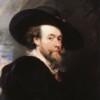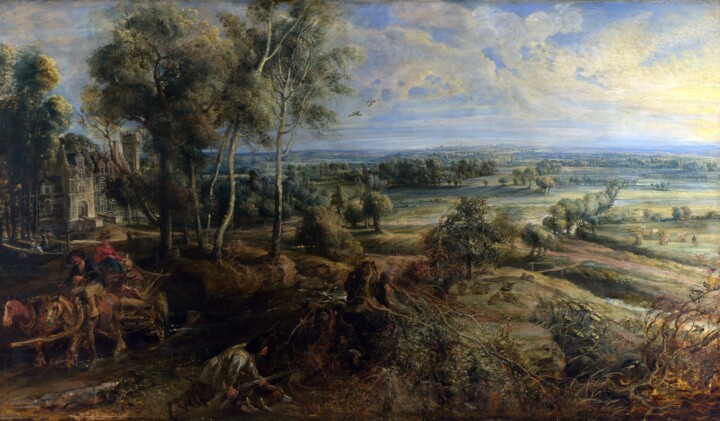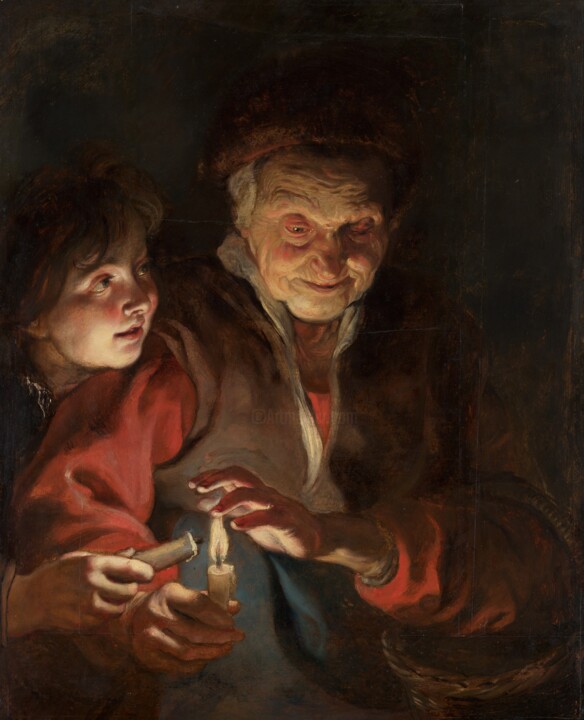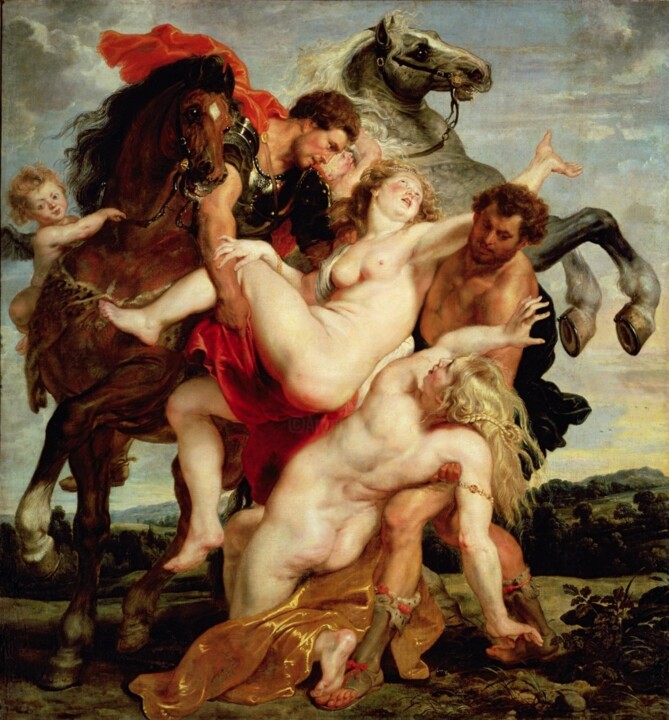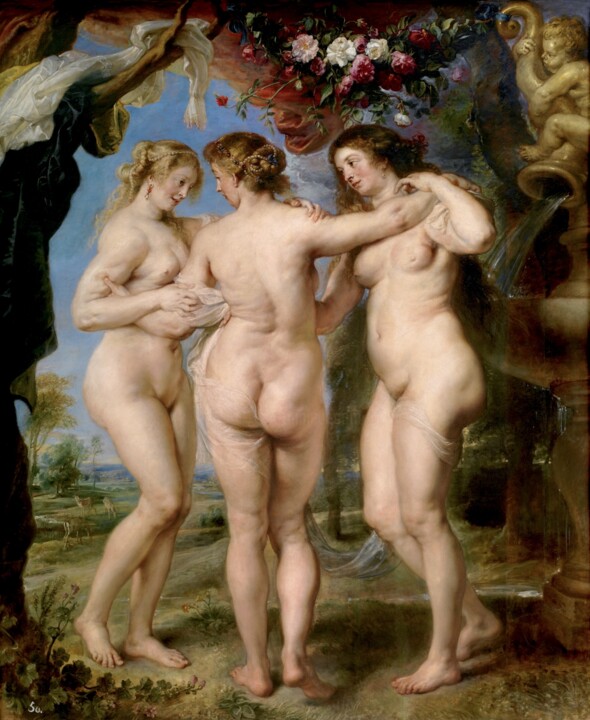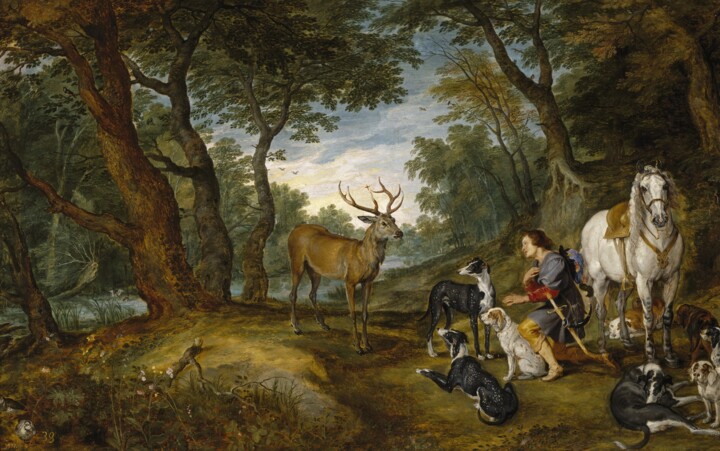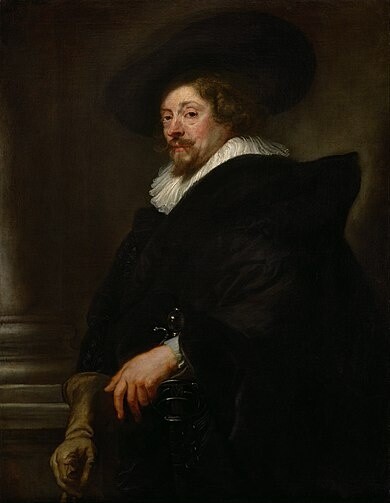 Pieter Paul Rubens, Self-Portrait, 1638 - 1639. Olio su tavola, 109,5×85 cm. Vienna: Kunsthistorisches Museum.
Pieter Paul Rubens, Self-Portrait, 1638 - 1639. Olio su tavola, 109,5×85 cm. Vienna: Kunsthistorisches Museum.
Who was Pieter Paul Rubens?
Pieter Paul Rubens was a Flemish artist who lived from 1577 to 1640. He was one of the most influential Baroque painters of his time and his works are known for their dramatic and dynamic compositions, vibrant colors, and skillful handling of light and shadow. Rubens was also known for his ability to depict complex allegorical and mythological subjects with great clarity and detail. In addition to his work as a painter, Rubens was also a diplomat and a scholar, and he had a profound influence on the art and culture of his time.
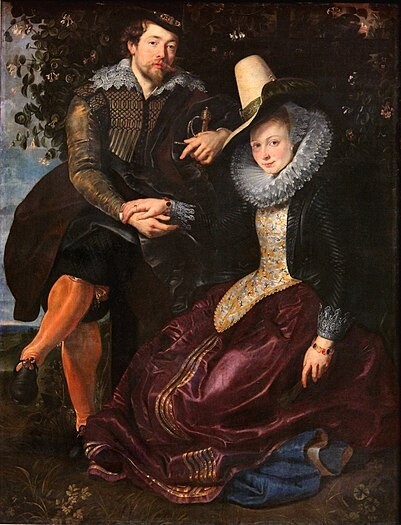 Pieter Paul Rubens, Self-portrait with his wife Isabella Brant, 1609-1610. Oil on canvas, 174×143 cm. Munich: Alte Pinakothek.
Pieter Paul Rubens, Self-portrait with his wife Isabella Brant, 1609-1610. Oil on canvas, 174×143 cm. Munich: Alte Pinakothek.
What are 5 stylistic characteristics of Peter Paul Rubens?
- Dramatic use of light and shadow: Rubens was known for his ability to create dramatic lighting effects in his paintings. He often used strong contrasts of light and shadow to create a sense of depth and three-dimensionality in his figures.
- Rich and vibrant color palette: Rubens' paintings are characterized by their rich and vibrant colors. He often used bold primary colors and strong contrasts to create dynamic and visually striking compositions.
- Fluid and energetic brushwork: Rubens' brushwork was often loose and expressive, with broad, sweeping strokes that conveyed a sense of movement and energy. He was known for his ability to capture the dynamic qualities of the human form in motion.
- Emphasis on the human form: Rubens was a master of the human form, and his paintings often feature highly realistic and anatomically precise depictions of the human body. He was particularly adept at capturing the musculature and movement of his subjects.
- Baroque theatricality: Rubens' paintings often have a theatrical quality, with highly dramatic and emotionally charged scenes. He was known for his ability to create a sense of grandeur and spectacle in his compositions, often featuring larger-than-life figures and dramatic gestures.
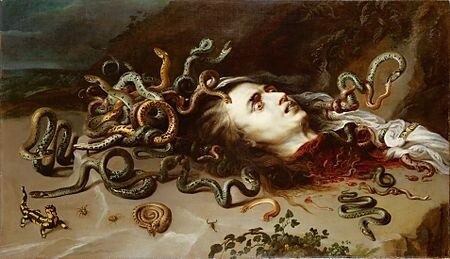 Pieter Paul Rubens, The Medusa, c. 1618. Oil on panel, 68×119 cm. Vienna: Kunsthistorisches.
Pieter Paul Rubens, The Medusa, c. 1618. Oil on panel, 68×119 cm. Vienna: Kunsthistorisches.
Baroque style
The Baroque style emerged in Europe in the early 17th century and lasted until the mid-18th century. It is characterized by an ornate, dramatic, and grandiose aesthetic that was intended to evoke strong emotions in the viewer.
Some key characteristics of the Baroque style include:
- Ornamentation: Baroque art is highly decorated with elaborate, intricate details, such as ornate patterns, intricate carving, and extravagant embellishments.
- Dramatic lighting: Baroque artists often used chiaroscuro, or dramatic contrasts of light and shadow, to create a sense of depth and drama in their works.
- Dynamic compositions: Baroque artists created compositions that were full of movement and energy, often featuring swirling, twisting forms and exaggerated poses.
- Emotion: Baroque art was intended to elicit strong emotions in the viewer, often through the use of intense facial expressions, dramatic gestures, and vivid colors.
- Grandeur: Baroque art was often commissioned by wealthy and powerful patrons, and as such, it often featured grand, monumental designs and impressive scale.
- Religious themes: Baroque art was closely tied to the Catholic Church, and many of the most famous Baroque works depict religious scenes or figures.
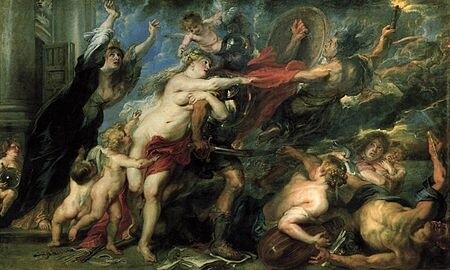 Pieter Paul Rubens, Consequences of War, 1637-1638. Oil on canvas, 206×345 cm. Florence: Palatine Gallery.
Pieter Paul Rubens, Consequences of War, 1637-1638. Oil on canvas, 206×345 cm. Florence: Palatine Gallery.
Baroque dynamism
Baroque dynamism refers to the characteristic energy and movement found in the art and architecture of the Baroque period, which spanned from the late 16th century to the mid-18th century. This period is known for its ornate and dramatic style, characterized by elaborate details, dramatic lighting, and a sense of theatricality. Baroque art often features dynamic, twisting forms and exaggerated gestures, conveying a sense of movement and action. This dynamism was intended to evoke powerful emotions in the viewer and to create a sense of grandeur and drama. Baroque architecture also featured dynamic forms and dramatic lighting, with ornate decoration and sweeping curves. Overall, the Baroque period was marked by a sense of energy and movement, expressed through both its art and architecture.
 Pieter Paul Rubens, The Garden of Love, 1630-1631.
Pieter Paul Rubens, The Garden of Love, 1630-1631.
Baroque and religion
Religion played a significant role in the development of the Baroque style, particularly in the Catholic countries of Europe. The Baroque period was marked by a strong emphasis on the Catholic Counter-Reformation, which sought to reassert Catholic influence in response to the Protestant Reformation. The Catholic Church used the Baroque style to convey its power and authority, creating elaborate, ornate spaces that were intended to inspire awe and piety in the faithful.
Baroque art often depicted religious themes and stories, with dramatic, emotional scenes intended to inspire devotion and piety. These works often featured a sense of theatricality, with exaggerated gestures and dynamic compositions designed to capture the viewer's attention and evoke a powerful emotional response.
Baroque architecture was similarly focused on religion, with grand churches and palaces designed to convey the wealth and power of the Church and its rulers. These structures often featured elaborate decoration, with ornate altarpieces, frescoes, and sculptures filling the spaces. The use of light and shadow was also an important aspect of Baroque architecture, with dramatic lighting effects designed to create a sense of awe and mystery.
Overall, religion was a driving force behind the development of the Baroque style, with the Catholic Church using art and architecture to convey its power and inspire devotion in the faithful.
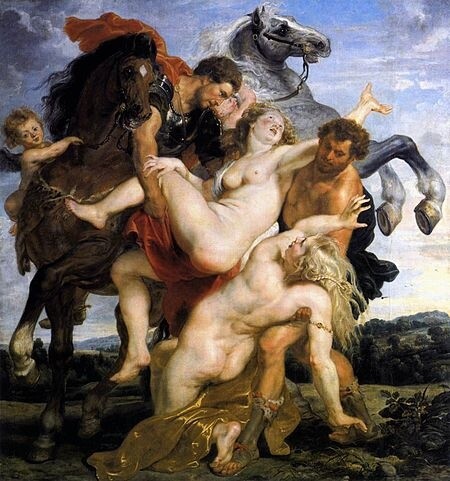 Pieter Paul Rubens, Rape of the Leucippides, 1615-1618. Oil on canvas, 224×211 cm. Munich: Alte Pinakothek.
Pieter Paul Rubens, Rape of the Leucippides, 1615-1618. Oil on canvas, 224×211 cm. Munich: Alte Pinakothek.
Rubens and Italian art influence
Italian art had a significant influence on the style of Peter Paul Rubens. Rubens, a Flemish Baroque painter, was heavily influenced by Italian Renaissance art, particularly the works of Michelangelo, Titian, and Caravaggio.
Rubens traveled to Italy in 1600, where he studied the works of these masters. He was particularly drawn to the dramatic use of light and shadow in Caravaggio's paintings, which he incorporated into his own work. Rubens also admired the sensuousness and richness of Titian's colors, which he emulated in his own use of color.
In addition, Rubens was influenced by the classical tradition of Italian art, particularly the works of ancient Roman and Greek artists. He incorporated classical elements into his paintings, such as the use of heroic figures, dynamic compositions, and classical motifs.
 Pieter Paul Rubens, The Judgement of Paris, 1636. 144.8 cm × 193.7 cm. London: National Gallery.
Pieter Paul Rubens, The Judgement of Paris, 1636. 144.8 cm × 193.7 cm. London: National Gallery.
Pictorial subjects
- Mythology: Rubens was particularly drawn to classical mythology and often depicted scenes from Greek and Roman legends. These paintings typically feature larger-than-life figures engaged in dramatic and dynamic action.
- Religion: Rubens was a devout Catholic and produced many religious paintings throughout his career. His religious works often feature highly emotive and dramatic scenes, with a focus on the suffering and sacrifice of Christ and his followers.
- History: Rubens was also interested in historical events and often painted scenes from ancient and contemporary history. These works often feature dramatic battle scenes or political events, and are characterized by their attention to detail and historical accuracy.
- Portraiture: Rubens was a skilled portrait painter and created many portraits of the wealthy and powerful individuals of his time. His portraits are characterized by their detailed and lifelike depictions of the sitter, as well as their ability to convey the sitter's personality and character.
- Landscapes: While not as common as some of his other subjects, Rubens did produce a number of landscape paintings throughout his career. These works often feature sweeping vistas and lush, detailed foliage, and are characterized by their attention to detail and sense of naturalism.
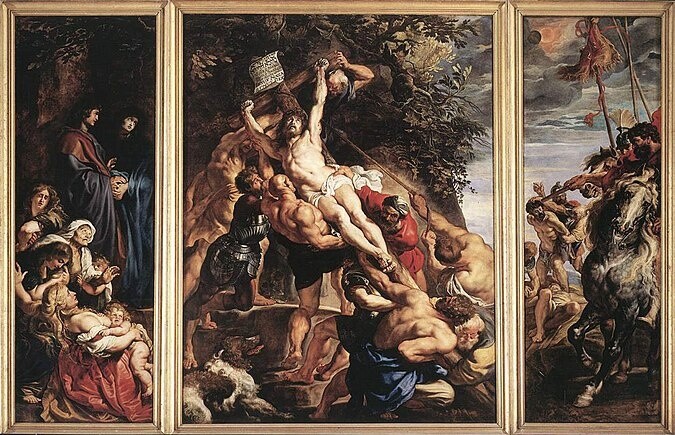 Pieter Paul Rubens, The Elevation of the Cross, 1610-11. Oil on wood, 462 cm × 341 cm. Antwerp: Cathedral of Our Lady.
Pieter Paul Rubens, The Elevation of the Cross, 1610-11. Oil on wood, 462 cm × 341 cm. Antwerp: Cathedral of Our Lady.
The Elevation of the Cross (1610–11)
"The Elevation of the Cross" is a famous painting created by Peter Paul Rubens between 1610 and 1611. The painting depicts the moment when Jesus Christ is lifted onto the cross, and it is one of the most celebrated examples of Baroque art.
The painting is enormous, measuring about 462 cm × 341 cm, and it is considered a masterpiece of Baroque art due to its dynamic composition and use of dramatic lighting. The central figure of Christ is shown in a powerful, dynamic pose, with his body contorted in pain and his face expressing agony.
The other figures in the painting, including the soldiers and the thieves on either side of Christ, are also shown in dramatic, dynamic poses, with their muscles tensed and their faces twisted in emotion. The overall effect is one of intense drama and emotional power, as Rubens captures the moment of Christ's sacrifice with vivid realism.
"The Elevation of the Cross" is a prime example of Rubens' mastery of Baroque style, which is characterized by its grandeur, dynamism, and emotional intensity. The painting remains a beloved masterpiece of Baroque art and a testament to Rubens' skill as a painter.
The workshop
This piece of art was not made entirely by Peter Paul Rubens, which is the case with many of Rubens' works. Rubens was very busy in the years before he moved to Antwerp. He had a lot of tasks that didn't just involve painting. Rubens was in charge of a workshop with a hierarchy of students, assistants, and collaborators who all worked together to make the picture. Rubens would have made all the sketches and plans for the works being made in his workshop. Rubens started making The Elevation of the Cross by using oil and a brush on a small plate. This oil sketch, which is also called a "modello," was used as a sample painting to show the patron how the general story and images would look. The patron paid special attention to the iconographic details. The helpers also used the modello as a guide to start the first steps of the full-size painting. Rubens's "Elevation of the Cross" didn't have any big changes made to the way it looks, but a few small things, like where the cross is, were changed. Rubens changed the figure on the right wing from a Niobid running away in the modello to a son of Niobe lying on the ground in the Antwerp triptych. By drastically shrinking this figure, he was able to show the art experts of his time that he was a master of his craft. Once the helpers had set up the overall layout, Rubens turned his attention to the people in the painting. During this stage, Rubens drew with chalk while live models stood in front of him in the poses that had been planned out in the modello. This set of separate drawings, along with the modello, were used to finish the large picture. Once the assistants had finished their parts, Rubens made sure to touch up each picture.
 The smaller version of "The Elevation of the Cross."
The smaller version of "The Elevation of the Cross."
The smaller version
The title of a smaller oil picture on paper of the triptych is also "The Elevation of the Cross."It was 60 x 126.5 cm at first, but was later made 70 x 131.5 cm. This smaller picture is an example of a changed version of the above triptych. This painting was also done by Rubens. He finished it around 1638 and gave it to Hans Witdoeck to use as a model. The smaller painting is different from the original, becuase it has the addition of color accents throughout the composition. The biggest change between the painting from 1611 and the one from 1638 is that the 1638 painting doesn't have any frames. Getting rid of the breaks made the scene flow better. People who weren't in the first version are added, and some changes have been made to the scenery. Because of its size, some people think that the picture was made as a separate piece from The Elevation of the Cross and given to Cornelis van der Geest as a gift. The picture is now a part of the permanent collection at the Art Gallery of Ontario. It was bought from George Holford in 1928.

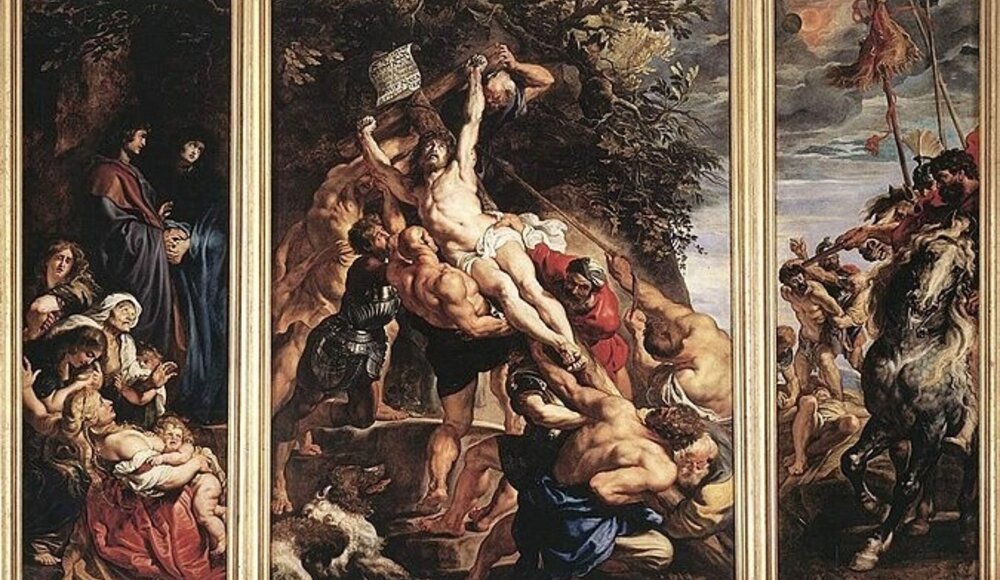
 Selena Mattei
Selena Mattei
